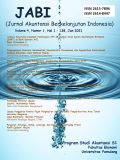Pengaruh Tunneling Incentive, Bonus Mechanism, Debt Covenant dan Tax Minimization terhadap Keputusan Transfer Pricing
DOI:
https://doi.org/10.32493/JABI.v4i3.y2021.p281-301Keywords:
Tunneling incentive, bonus mechanism, debt covenant, tax minimizationAbstract
Transfer pricing practices can be caused by a special relationship where the company can take advantage of the opportunities that exist in the company. This study was used to examine the variables of tunneling incentive, bonus mechanism, debt covenant, and tax minimization on transfer pricing decisions. This research uses the help of WarpPLS 6.0 software. The technique used is purposive sampling by determining the various criteria needed. This study shows that tunneling incentives have an effect on transfer pricing with the implication that the greater the share ownership, the higher the level of the company in conducting tunneling activities to influence transfer pricing decisions. The bonus given to the manager can be seen from the quality of the manager's work so that the greater the bonus received, the higher the company's motivation to carry out transfer pricing activities. Meanwhile, debt covenants and tax minimization have no effect on transfer pricing decisions. The implication is explained that if the reported profit is higher, it will lead to technical negligence and become the cause of the company not being interested in carrying out transfer pricing practices.
References
Christensen, T. E., Cottrell, D. M., & Baker, R. E. (2014). Advanced financial accounting. In The British Accounting Review (Ten Editio). McGraw-Hill.
Darussalam, Septriadi, D., & Kristiaji, B. B. (2013). Transfer Pricing: Ide, Strategi, dan Panduan Praktis dalam Perspektif Pajak Internasional. DANNY DARUSSALAM Tax Center. http://www.dannydarussalam.com/
Devi, D. K., & Suryarini, T. (2020). The Effect of Tax Minimization and Exchange Rate on Transfer Pricing Decisions with Leverage as Moderating. Accounting Analysis Journal, 9(2), 110–115. https://doi.org/10.15294/aaj.v9i2.36469
Ghozali, I., & Latan, H. (2015). Partial Least Squares, Konsep Teknik dan AplikasiDengan Program Smart PLS 3.0 (2nd ed.). Universitas Dipenogoro Semarang.
Ginting, D. B., Triadiarti, Y., & Purba, E. L. (2019). Pengaruh Profitabilitas, Pajak, Mekanisme Bonus, Kepemilikan Asing, Debt Covenant Dan Intangible Assets Terhadap Transfer Pricing (Studi Empiris Pada Perusahaan Manufaktur Yang Terdaftar Di Bei Tahun 2015 – 2017). Akuntansi, Keuangan & Perpajakan Indonesia (JAKPI), 2(3), 32–40.
Godfrey, J. M., Hodgson, A., Tarca, A., Hamilton, J., & Holmes, S. (2010). Accounting Theory. In Accounting Theory (7th ed). John Wiley & Sons.
Hidayat, W. W. (2019). (2018). Pengaruh Pajak Dan Tunneling Incentive Terhadap keputusan Transfer Pricing Pada Perusahaan Pertambangan Yang Terdaftar Di Bursa Efek Indonesia (BEI) Periode 2012-1017. Seminar Nasional Pakar Ke 1, 15(1), hal. 235-240.
Hongren, C. T., Datar, S. M., & Rajan, M. V. (2015). Cost Accounting: A Managerial Emphasize. In Pearson (fifteenth).
Jensen, M. C., & Meckling, W. H. (1976). THEORY OF THE FIRM: MANAGERIAL BEHAVIOR, AGENCY COSTS AND OWNERSHIP STRUCTURE. Journal of Financial Economics, 72, 305–360. https://doi.org/10.1177/0018726718812602
La Porta, R., Lopez-De-Silanes, F., Shleifer, A., & Vishny, R. (2000). Investor protection and corporate governance. Journal of Financial Economics, 58(1–2), 3–27. https://doi.org/10.1016/s0304-405x(00)00065-9
Matsuoka, A. (2018). What made base erosion and profit shifting project possible? Identifying factors for building momentum for reform of international taxation. Journal of Financial Crime, 25(3), 795–810. https://doi.org/10.1108/JFC-08-2017-0072
Refgia, T., Ratnawati, V., & Rusli. (2017). Pengaruh Pajak, Mekanisme Bonus, Ukuran Perusahaan, Kepemilikan Asing, Dan Tunneling Incentive Terhadap Transfer Pricing. JOM Fekon, 4(1), 1960–1970.
Schroeder, R. G., Clark, M. W., & Cathey, J. M. (2005). Financial Accounting Theory and Analysis: Text and Cases (8 ed). Wiley.
Sholihin, M., & Ratmono, D. (2013). Analisis SEM-PLS dengan WarpPLS 3.0. Penerbit Andi.
Spiceland, C., Spiceland, D., & Njoroge, P. K. (2018). Tourist Trap: The new lease accounting standard and debt covenants. Journal of Accounting Education, 45(October 2017), 45–59. https://doi.org/10.1016/j.jaccedu.2018.08.001
Sugiyono. (2013). METODE PENELITIAN KUANTITAIF, KUALITATIF, DAN R&D. In Bandung. Alfabeta.
Tjandrakirana, R., & Ermadiani. (2020). TAX , DEBT COVENANT AND EXCHANGE RATE ( ANALISIS ATAS FENOMENA TRANSFER PRICING ). 5(1), 26–39.
Wareza, M. (2019). Disebut Terlibat Transfer Pricing Adaro, Siapa Coaltrade? CBNC Indonesia. https://www.cnbcindonesia.com/news/20190704205102-4-82830/disebut-terlibat-transfer-pricing-adaro-siapa-coaltrade
Watt, R. L., & Zimmerman Jerold L. (1986). Positive Accounting Theory. McGraw-Hill.
Xue, L., Wang, W., & Zhang, M. (2020). Research on bonus-penalty mechanism of pollution abatement: A case study of the northeastern region of China. Journal of Cleaner Production, 267, 122069. https://doi.org/10.1016/j.jclepro.2020.122069
Downloads
Published
Issue
Section
License
Authors who publish with this journal agree to the following terms:
- Authors retain copyright and grant the journal right of first publication with the work simultaneously licensed under a Creative Commons Attribution License that allows others to share the work with an acknowledgement of the work's authorship and initial publication in this journal.
- Authors are able to enter into separate, additional contractual arrangements for the non-exclusive distribution of the journal's published version of the work (e.g., post it to an institutional repository or publish it in a book), with an acknowledgement of its initial publication in this journal.
- Authors are permitted and encouraged to post their work online (e.g., in institutional repositories or on their website) prior to and during the submission process, as it can lead to productive exchanges, as well as earlier and greater citation of published work (See The Effect of Open Access)

This work is licensed under a Creative Commons Attribution-ShareAlike 4.0 International License.


 PUBLICATION ETHICS
PUBLICATION ETHICS FOCUS AND SCOPE
FOCUS AND SCOPE EDITORIAL TEAM
EDITORIAL TEAM REVIEW PROCESS
REVIEW PROCESS CONTACT US
CONTACT US AUTHOR GUIDELINES
AUTHOR GUIDELINES




